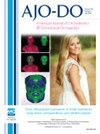全自动下颌分割的深度学习技术评估。
IF 2.7
2区 医学
Q1 DENTISTRY, ORAL SURGERY & MEDICINE
American Journal of Orthodontics and Dentofacial Orthopedics
Pub Date : 2025-02-01
DOI:10.1016/j.ajodo.2024.09.006
引用次数: 0
摘要
本研究旨在评估一个开源的、临床医生训练的、用户友好的基于卷积神经网络的下颌自动分割模型的精度。方法:收集符合入选标准的锥束ct扫描55张,分为试验组和训练组。使用MONAI (Medical Open Network for Artificial Intelligence)标签主动学习工具扩展对自动模型进行训练。为了评估模型的性能,将试验组的15个锥束计算机断层扫描输入模型。从人工分割数据中获得地面真值。计算了Dice相似系数、Hausdorff 95%、准确率、召回率和分割时间等指标。此外,分析了自动分割结果与人工分割结果的表面偏差和体积差异。结果:自动模型与人工分割结果具有较高的相似度,平均Dice相似系数为0.926±0.014。Hausdorff距离为1.358±0.466 mm,平均查全率和查准率分别为0.941±0.028和0.941±0.022。在整个下颌骨和11个不同解剖区域表面偏差的算术平均值上,差异无统计学意义。体积比较,两组间差异为1.62 mm³,差异无统计学意义。结论:自动化模型适合临床使用,与参考手册方法高度一致。临床医生可以使用开源软件开发定制的自动分割模型,以满足他们的特定需求。本文章由计算机程序翻译,如有差异,请以英文原文为准。
Assessment of deep learning technique for fully automated mandibular segmentation
Introduction
This study aimed to assess the precision of an open-source, clinician-trained, and user-friendly convolutional neural network-based model for automatically segmenting the mandible.
Methods
A total of 55 cone-beam computed tomography scans that met the inclusion criteria were collected and divided into test and training groups. The MONAI (Medical Open Network for Artificial Intelligence) Label active learning tool extension was used to train the automatic model. To assess the model’s performance, 15 cone-beam computed tomography scans from the test group were inputted into the model. The ground truth was obtained from manual segmentation data. Metrics including the Dice similarity coefficient, Hausdorff 95%, precision, recall, and segmentation times were calculated. In addition, surface deviations and volumetric differences between the automated and manual segmentation results were analyzed.
Results
The automated model showed a high level of similarity to the manual segmentation results, with a mean Dice similarity coefficient of 0.926 ± 0.014. The Hausdorff distance was 1.358 ± 0.466 mm, whereas the mean recall and precision values were 0.941 ± 0.028 and 0.941 ± 0.022, respectively. There were no statistically significant differences in the arithmetic mean of the surface deviation for the entire mandible and 11 different anatomic regions. In terms of volumetric comparisons, the difference between the 2 groups was 1.62 mm³, which was not statistically significant.
Conclusions
The automated model was found to be suitable for clinical use, demonstrating a high degree of agreement with the reference manual method. Clinicians can use open-source software to develop custom automated segmentation models tailored to their specific needs.
求助全文
通过发布文献求助,成功后即可免费获取论文全文。
去求助
来源期刊
CiteScore
4.80
自引率
13.30%
发文量
432
审稿时长
66 days
期刊介绍:
Published for more than 100 years, the American Journal of Orthodontics and Dentofacial Orthopedics remains the leading orthodontic resource. It is the official publication of the American Association of Orthodontists, its constituent societies, the American Board of Orthodontics, and the College of Diplomates of the American Board of Orthodontics. Each month its readers have access to original peer-reviewed articles that examine all phases of orthodontic treatment. Illustrated throughout, the publication includes tables, color photographs, and statistical data. Coverage includes successful diagnostic procedures, imaging techniques, bracket and archwire materials, extraction and impaction concerns, orthognathic surgery, TMJ disorders, removable appliances, and adult therapy.

 求助内容:
求助内容: 应助结果提醒方式:
应助结果提醒方式:


